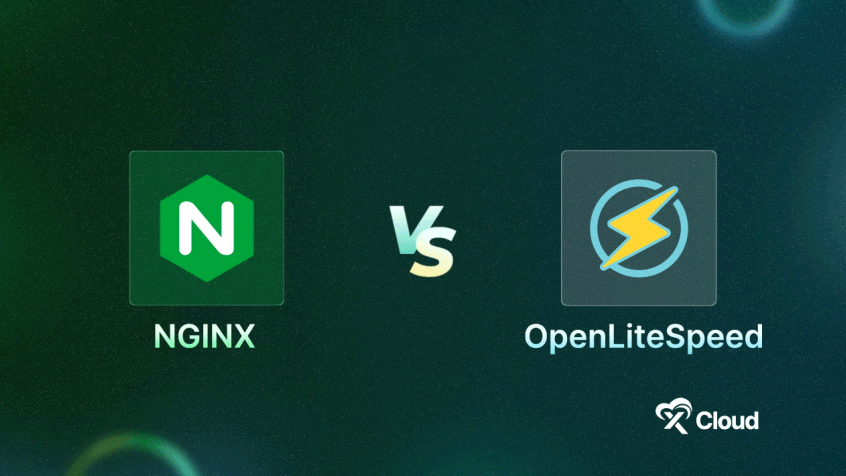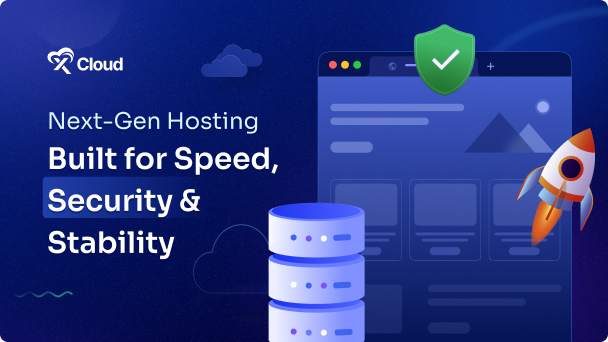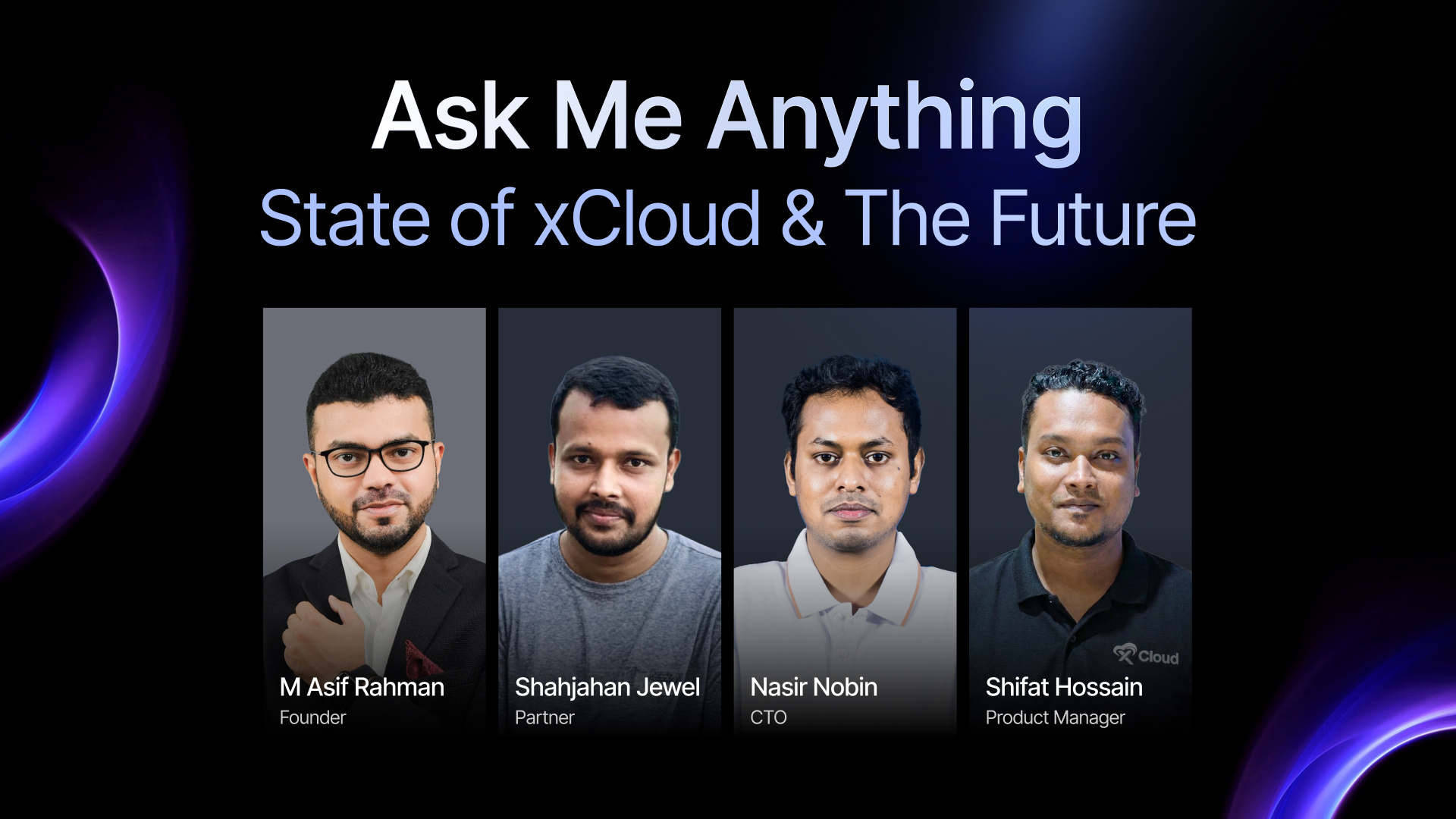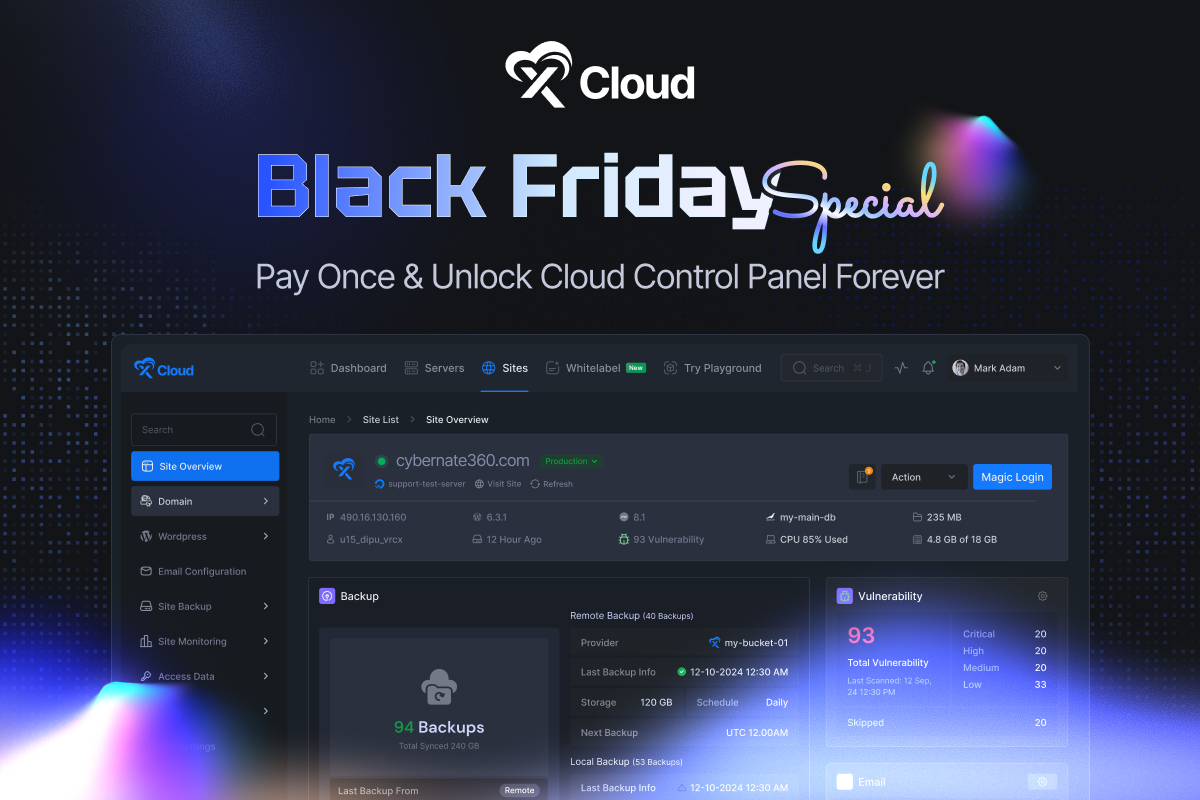When it comes to choosing the right web server for your website, the decision often boils down to two prominent contenders: NGINX and OpenLiteSpeed. Both of these web servers are renowned for their speed and efficiency, but which one truly stands out as the faster option for your site? In this comparison of NGINX vs OpenLiteSpeed, we aim to help you understand which web server might offer better server speed comparison and overall performance of our site.

Though xCloud offers both the NGINx and OLS web servers. By examining different factors like the web, you can make an informed decision that enhances your site’s functionality and user satisfaction.
🔥NGINX Server And Its Key Features
NGINX is a highly versatile and powerful open-source web server, renowned for its exceptional performance and scalability. Initially developed in 2004 by Igor Sysoev, NGINX was designed to handle the C10k problem or the challenge of serving 10,000 simultaneous connections. Since then, it has evolved into a multi-faceted platform that excels in a variety of roles, including web serving, reverse proxying, load balancing, and more.
Performance And Scalability
NGINX’s event-driven architecture is at the heart of its performance. This non-blocking design allows NGINX to efficiently handle multiple requests simultaneously, making it an excellent choice for high-traffic websites and applications. Its ability to serve static content rapidly and balance load across multiple backend servers contributes to its reputation as a performance powerhouse.

Flexible Configuration
NGINX offers flexible configuration through its modular design and text-based configuration files. This flexibility allows administrators to customise settings for various server blocks, locations, and directives, tailoring NGINX to suit different applications and use cases. The configuration syntax, while powerful, does have a learning curve, but it provides granular control over server behavior.
Reverse Proxy And Load Balancing
NGINX excels as a reverse proxy and load balancer, distributing incoming traffic across multiple backend servers. This functionality enhances scalability, reliability, and performance, making NGINX ideal for large-scale applications and microservices architectures. It supports various load balancing algorithms, including round-robin, least connections, and IP hash, to optimize traffic distribution.
Security And Reliability
NGINX offers robust security features, including SSL/TLS support, access control, and integration with security modules like ModSecurity. Its lightweight and efficient design contributes to its reliability, allowing it to handle large volumes of traffic with minimal resource consumption.
Overall, NGINX is a versatile powerhouse, delivering exceptional performance, scalability, and flexibility for a wide range of web applications and services.
🔥OpenLiteSpeed Server And Its Notable Features
OpenLiteSpeed is an open-source web server that represents the essence of speed and efficiency, offering a lightweight yet powerful platform for delivering web content. It is a part of the LiteSpeed family of servers and shares many of the performance optimisations found in the proprietary LiteSpeed Enterprise Server. OpenLiteSpeed excels in delivering high performance, particularly for dynamic PHP applications, making it a popular choice among performance-conscious web administrators and developers.

Optimized for Speed
OpenLiteSpeed’s hallmark is its event-driven architecture, which ensures efficient handling of concurrent connections. This architecture enables the server to process multiple requests simultaneously without consuming excessive resources. The server is designed to minimise latency and maximize throughput, delivering a seamless user experience even under high traffic loads.
Built-in Caching
One of OpenLiteSpeed’s standout features is its built-in caching mechanism, LiteSpeed Cache. This caching system accelerates content delivery by storing frequently accessed data, reducing the need for repeated processing. LiteSpeed Cache is particularly effective for WordPress sites, as it includes specific optimization features for this popular content management system.
Optimized PHP Handling
OpenLiteSpeed’s LSAPI (LiteSpeed Application Programming Interface) for PHP handling is a key differentiator, offering superior performance compared to traditional PHP processing methods. LSAPI enhances PHP script execution, making OpenLiteSpeed an excellent choice for PHP-heavy applications like WordPress, Joomla, and Drupal.
Ease of Use
OpenLiteSpeed features a user-friendly web-based administration panel, making configuration straightforward. This ease of use, combined with its performance advantages, makes OpenLiteSpeed an attractive choice for developers and administrators seeking a fast, efficient, and user-friendly web server.
⚔️NGINX vs OpenLiteSpeed: Evaluating the Speed And Efficiency
When it comes to choosing a web server, speed and efficiency are paramount considerations. Both NGINX and OpenLiteSpeed are renowned for their high performance and scalability. However, the way they achieve this performance and the specific scenarios in which they excel can differ significantly. Let’s examine various performance aspects to discern which server offers superior speed and efficiency.

How Quickly Can NGINX And OpenLiteSpeed Serve Content?
The speed of a web server is crucial, particularly for websites that handle a lot of traffic or require rapid responses. For static content such as images and HTML files, both NGINX and OpenLiteSpeed are highly efficient. However, OpenLiteSpeed often has a slight edge, particularly when serving smaller files. This advantage stems from its optimized event-driven architecture, which allows it to process requests with minimal overhead.
When it comes to dynamic content, such as PHP scripts, OpenLiteSpeed again showcases superior performance. Its LiteSpeed API (LSAPI) is specifically designed for efficient PHP handling, making OpenLiteSpeed especially suitable for PHP-heavy applications like WordPress, Joomla, and Drupal. NGINX, while competent with dynamic content, may require more tuning and configuration to achieve similar performance, particularly when using FastCGI or PHP-FPM.
How Efficiently Do NGINX And OpenLiteSpeed Use System Resources?
Efficient resource usage is another critical factor, especially when system resources are limited or expensive. In terms of memory usage, OpenLiteSpeed typically consumes less under high traffic loads, thanks to its streamlined event-driven architecture and built-in caching mechanisms. NGINX, while generally efficient, may need additional caching solutions or specific tuning to match OpenLiteSpeed’s memory efficiency.
Regarding CPU usage, OpenLiteSpeed also generally outperforms NGINX, particularly under high concurrency. OpenLiteSpeed’s streamlined architecture enables it to handle numerous simultaneous connections with minimal CPU consumption. NGINX, while efficient, may require more CPU resources, especially without proper optimisation and tuning.
How Well Can NGINX And OpenLiteSpeed Scale with Traffic?
Scalability is crucial for web servers that anticipate growing or fluctuating traffic. NGINX excels in horizontal scalability due to its robust load-balancing capabilities. It can distribute traffic across multiple backend servers effectively, making it ideal for large-scale applications and high-traffic websites. NGINX’s flexible load balancing algorithms, such as round-robin, least connections, and IP hash, offer various strategies for traffic distribution.
OpenLiteSpeed, on the other hand, offers superior vertical scalability thanks to its efficient resource utilization. It performs exceptionally well on single-server setups, particularly for PHP-based applications. This makes it an excellent choice for small to medium-sized websites and web hosting environments where vertical scaling is more feasible or desirable than horizontal scaling.
How Well Can NGINX And OpenLiteSpeed Handle Multiple Connections?
Concurrency handling is vital for web servers dealing with multiple simultaneous connections. Both NGINX and OpenLiteSpeed utilise event-driven architectures that excel in handling concurrent connections. However, OpenLiteSpeed tends to offer better performance under high concurrency, particularly for dynamic content. NGINX, while efficient, may require additional configuration and optimisation to handle similar levels of concurrent connections effectively.

How Quickly Can NGINX And OpenLiteSpeed Respond to Requests?
Latency, or the delay before a transfer of data begins, is another important factor in web server performance. OpenLiteSpeed often has an edge in this regard due to its optimized processing and built-in caching, resulting in faster response times for both static and dynamic content. NGINX performs well, but may require additional tuning, such as optimizing buffer sizes and enabling caching, to achieve similar low-latency performance.
Which Server Is Best for Your Needs?
When it comes to overall performance, both NGINX and OpenLiteSpeed offer exceptional efficiency and scalability, but they excel in different areas. OpenLiteSpeed is particularly strong in dynamic content handling, memory efficiency, and high concurrency situations, making it ideal for PHP-based applications and small to medium-sized setups. NGINX, on the other hand, shines in horizontal scalability, static content delivery, and load balancing, making it suitable for large-scale applications and complex setups.
The choice between NGINX and OpenLiteSpeed ultimately depends on the specific needs of your website or application. For PHP-heavy, high-concurrency environments, OpenLiteSpeed may be the best choice. For large-scale, horizontally scalable setups, NGINX might be more appropriate. Understanding the strengths and weaknesses of each server will help you select the one that best fits your requirements and ensures optimal performance for your site.
Caching Mechanisms of NGINX vs OpenLiteSpeed
Caching is fundamental to enhancing web performance by storing copies of files so they can be served faster to users. NGINX utilizes fastcgi_cache for dynamic content and proxy_cache for static resources, which are highly effective but require manual configuration. In contrast, OpenLiteSpeed comes with built-in caching functionalities like LiteSpeed Cache, which is known for its automatic page caching capabilities. This feature can dramatically decrease page load time without needing the user to fine-tune settings frequently.
Tips for Optimizing Web Server Speed
Regardless of the chosen web server, there are several strategies to enhance its performance. Here are some tips for optimizing the speed of both NGINX and OpenLiteSpeed:
• Effective Caching: Implement caching mechanisms to store static and dynamic content, reducing the need for repetitive processing and speeding up response times.
• Resource Allocation: Ensure adequate hardware resources like CPU and RAM are allocated based on the server’s load and traffic patterns.
• Content Compression: Use compression algorithms such as Gzip for NGINX or Brotli for OpenLiteSpeed to reduce the size of data transferred between the server and clients, enhancing load times.
• Regular Updates: Keep the web server software updated to benefit from the latest performance improvements and security patches.
By employing these optimization techniques, both web servers can perform at their peak, significantly improving the overall site performance.
Build Your Server from NGINX Or OpenLiteSpeed in xCloud
xCloud is an innovative web hosting platform that provides users with powerful tools and technologies to launch and manage their websites with ease. Offering a suite of hosting solutions tailored to various needs, xCloud stands out for its commitment to performance, security, and scalability. Whether you’re a small business owner, a blogger, or a large enterprise, xCloud offers the reliability and flexibility needed to support your online ventures.
xCloud understands that different projects have different needs, which is why it offers the choice between two leading web server technologies: NGINX and OpenLiteSpeed. This choice allows users to tailor their hosting environment to best suit their website’s specific requirements.
Whether you prioritize NGINX for its efficiency in handling websites with high traffic and serving static content or OpenLiteSpeed for its exceptional performance with dynamic content and ease of use, xCloud facilitates a hosting solution that aligns with your goals. Both servers are renowned for their speed and stability, ensuring that every website hosted on xCloud benefits from top-tier technology.
With xCloud, setting up your site on either NGINX or OpenLiteSpeed is straightforward, thanks to xCloud’s user-friendly platform. Moreover, xCloud’s support team is always on hand to help you make the best decision and assist with any technical queries or issues you might encounter, making the process of building and growing your online presence as smooth as possible. Choose xCloud, and take advantage of the flexibility to use either NGINX or OpenLiteSpeed based on your website’s needs and your personal or business objectives.
⚔️ Choosing Between NGINX vs OpenLiteSpeed
There are different types of website hosting available; cloud hosting is one of them. NGINX and OpenLiteSpeed are both popular in the cloud hosting field. The decision between NGINX and OpenLiteSpeed often comes down to specific needs regarding performance, ease of management, and server resource availability.
NGINX is a proven solution for high-traffic sites needing robust load balancing and static content delivery, while OpenLiteSpeed offers advantages for dynamic content sites looking for ease of use and effective built-in caching. Let’s have a look at a quick data table to help you in making decisions:
| Aspect | NGINX | OpenLiteSpeed |
| Performance | High-performance, event-driven architecture; excels with static content. | Efficient event-driven design; slightly faster in dynamic content scenarios. |
| Caching | Supports caching via third-party modules; requires manual configuration. | Built-in server-level caching; includes LiteSpeed Cache plugin for WordPress. |
| Ease of Configuration | Configured through text-based files; may require more expertise. | User-friendly web-based GUI; easier for non-technical users. |
| Apache Compatibility | Independent of Apache configurations; requires manual rewrite of rules. | Compatible with Apache configurations, including .htaccess support. |
| Resource Usage | Lightweight design; efficient resource consumption. | Efficient resource usage; suitable for servers with limited resources. |
| Security Features | Robust security features, including rate limiting and SSL/TLS support. | Includes security features like mod_security support and DDoS protection. |
| Community Support | Large and active community; extensive documentation available. | Active community support; growing user base. |
| HTTP/3 Support | Yes, with additional configuration. | Yes, natively supported. |
| Load Balancing | Yes, supports advanced load balancing features. | Yes, supports load balancing. |
| WebSocket Support | Yes, supports WebSockets. | Yes, supports WebSockets. |
| Scripting Language Support | Supports PHP, Python, Perl, Ruby, and more. | Supports PHP, Ruby, Python, Perl, Java, etc. |
| Server APIs | Supports CGI, FCGI, uwsgi, SCGI, and more. | Supports LiteSpeed SAPI, CGI, FCGI, Proxy, AJPv13. |
Both web servers are capable of delivering excellent website speed and server performance, but your choice will ultimately depend on your technical comfort level, specific site requirements, and the type of content your site predominantly serves. Experimenting with both servers in a test environment may provide further insights into which server works best with your specific setup.
NGINX vs OpenLiteSpeed: Choose the Faster Web Server Wisely
When it comes to choosing between NGINX and OpenLiteSpeed, there is no one-size-fits-all answer. With xCloud, you have the ability to choose any of the web servers to deploy your server and build dream sites seamlessly. Both servers offer exceptional capabilities tailored to different needs and preferences. Your choice should align with your site’s requirements, balancing performance, security, and cost to best support your online presence.
If you have found this blog helpful, feel free to subscribe to our blogs for valuable tutorials, guides, knowledge, and tips on web hosting and server management. You can also join our Facebook community to share insights and engage in discussions.







































